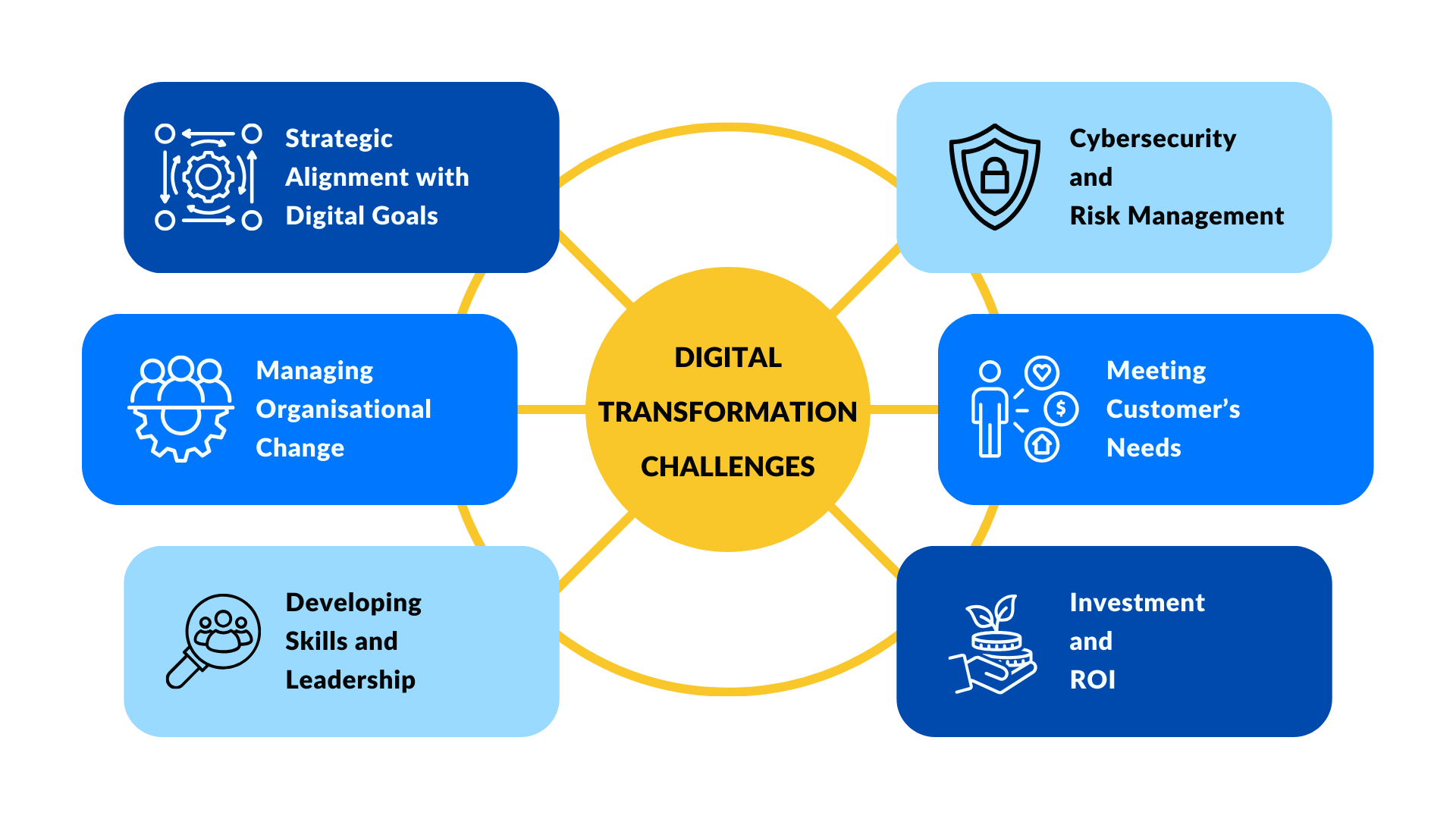In today's fast-paced market, businesses must embrace digital transformation to stay ahead of the competition. However, this transition has its challenges. Outdated legacy systems, resistance to change, lack of expertise, and cybersecurity threats can all hinder progress.
To succeed in this environment, it is crucial to overcome these hurdles. Businesses can unlock new opportunities and achieve growth by addressing each obstacle strategically.
So, let's look at these challenges and find practical solutions to overcome them.
Table of Contents
Why Is Digital Transformation Difficult?
Digital Transformation Challenges
Overcoming Digital Transformation Challenges
Conclusion
Why Is Digital Transformation Difficult?
While essential, digital transformation presents challenges that can make the journey arduous for many organisations. The difficulty stems from several factors intrinsic to the transformation itself.
-
Complexity of Integration: Integrating new digital technologies into existing systems is inherently complex. Organisations often deal with legacy systems that must be designed to work with the latest technologies. This complexity requires technical expertise and also significant time and investment.
-
Cultural Resistance: Another major obstacle is cultural resistance within organisations. Change can be unsettling, and the shift towards digital-first operations often meets with apprehension from employees accustomed to traditional working methods. Overcoming this resistance requires a change in mindset across all levels of the organisation. This process is easier said than done.
-
Rapid Pace of Technological Advancement: The rapid evolution of technology means that digital transformation is not a one-time project but a continuous process of adaptation. Keeping up with the pace of change, from artificial intelligence to blockchain, demands constant vigilance and flexibility. This relentless pace can be overwhelming for organisations that struggle with agility.
-
Security Concerns: As digital footprints expand, so too do the potential vulnerabilities to cyber threats. Ensuring data security and compliance with evolving privacy laws adds another layer of complexity to digital transformation efforts. Organisations must prioritise cybersecurity measures, which can be costly and require specialised knowledge.
-
Skill Gaps: The digital era requires a new set of skills, many of which are in short supply. The gap between the digital skills needed and the skills available within the organisation can hinder the pace of transformation. Addressing this gap means significant investment in training and development or acquiring new talent, which can be challenging.
-
Alignment with Business Objectives: Lastly, aligning digital transformation initiatives with broader business objectives can be challenging. Digital projects can quickly become disconnected from the organisation's core goals, leading to initiatives that fail to deliver real value. Ensuring alignment requires ongoing communication between IT and business leaders, a synergy that can be challenging.

Digital Transformation Challenges
Leaders face a wide array of hurdles in their quest to transform digitally. These aren't limited to the tech side; strategic planning, company culture, and the organisation's structure play equally pivotal roles.
Why does this matter? Understanding these challenges is crucial for any leader aiming to navigate them effectively. Armed with statistics and insights from various industries, let's explore these challenges.
Strategic Alignment with Digital Goals
Imagine trying to fit a square peg into a round hole. That's what it feels like when digital initiatives clash with a company's objectives. Research points out a sobering reality: fewer than one-third of digital transformations enhance company performance, with a mere 16% maintaining long-term improvements.
This statistic highlights the necessity for a vision that syncs digital and business goals. Without this alignment, projects may scatter, lose effectiveness, or backfire.
Managing Organisational Change
How do people typically react to change? With resistance. This human tendency can significantly hinder digital transformation. Findings reveal that organisations with remarkable change management practices are six times more likely to hit their project targets. This fact underscores the importance of exemplary leadership in guiding change, showing the way forward, and supporting teams during these shifts.
Developing Skills and Leadership
The tech world moves fast, demanding a workforce that keeps pace. Yet, the challenge of fostering skills to spearhead digital initiatives looms large. According to the World Economic Forum, by 2025, more than half of all employees will need significant re-skilling or up-skilling.
Additionally, cultivating leaders who can smoothly steer the company through these transitions is crucial. After all, successful digital transformation hinges on technology and people who can wield it effectively.
Cybersecurity and Risk Management
With greater digital presence comes increased vulnerability to cyber threats. A projection suggests global cybercrime costs will reach $10.5 trillion annually by 2025. This forecast highlights the imperative for a forward-thinking approach to cybersecurity, weaving it into the digital strategy from the get-go.
Meeting Customer’s Needs
As new developments enhance customer service, expectations rise, challenging businesses. Despite years of digital transformation efforts, the dynamic nature of customer desires requires ongoing adaptation. Organisations must, therefore, continuously invest in advanced digital solutions to keep pace with customers' growing demands for more intuitive services.
Investment and ROI
The economics of digital transformation should be considered. How do you justify the upfront costs of new technologies against the expected returns? There's a dichotomy where businesses fear falling behind without digital transformation. Yet, only some CEOs are confident in their organisation's quick adaptation capabilities. This discrepancy signals the challenge of managing the financial aspects of digital projects.

Why Is Digital Transformation Difficult?
Guiding an organisation through the intricacies of digital transformation demands a multifaceted approach. Below are strategies fortified by insights and statistics designed to help leaders champion digital success.
Cultivating a Digital Culture
Why is a digital-first mindset crucial? It fuels experimentation, adaptability, and lifelong learning. Companies with a pronounced digital culture are 2.5 times more likely to achieve outstanding performance. Leaders can cultivate this environment by:
- Promoting Digital Understanding: Demystify the digital transformation process for everyone in the organisation.
- Encouraging Innovation: Foster a space where new ideas are celebrated and learning from failures is encouraged.
Leading by Example
The impact of leadership on digital initiatives must be considered. Executives should:
- Use Digital Tools Actively: Show your commitment to digital by integrating new technologies into your daily work.
- Maintain Project Visibility: Stay involved in digital projects, reinforcing your commitment to the company's digital future.
Managing the Team Strategically
Bridging the digital talent gap is essential. Adaptability and collaboration are among the most sought-after soft skills, yet often lacking. Leaders should:
- Invest in Training: Equip your team with the skills needed for tomorrow.
- Showcase Commitment to Digital Growth: Attract digital collaborators by promoting an innovative and growth-oriented company culture.
Prioritising Data Security and Compliance
As digital footprints expand, so does the target for cyber threats. A survey found that nearly 30% of companies invest in digital transformation to improve security. Key steps include:
- Early Integration of Security Measures: Embed cybersecurity considerations into the planning stages of digital projects.
- Ongoing Risk Evaluation: Regularly assess and update your security protocols to avoid potential threats.
Setting and Adapting Goals
Keeping the digital transformation journey on track requires clear benchmarks for success. Essential practices include setting specific, measurable goals aligned with business objectives and being ready to tweak strategies based on feedback.
Conclusion
The path to digital transformation is complex and challenging. Still, businesses can effectively navigate these challenges with strategic planning, comprehensive change management, skill development, enhanced security measures, and thoughtful financial planning.
Embracing these strategies will address the immediate hurdles and lay the groundwork for sustained digital innovation and competitiveness.
Embark on your transformation journey with confidence. Explore our digital transformation service to unlock new growth opportunities and drive your business forward. Learn how we can support your digital evolution.



